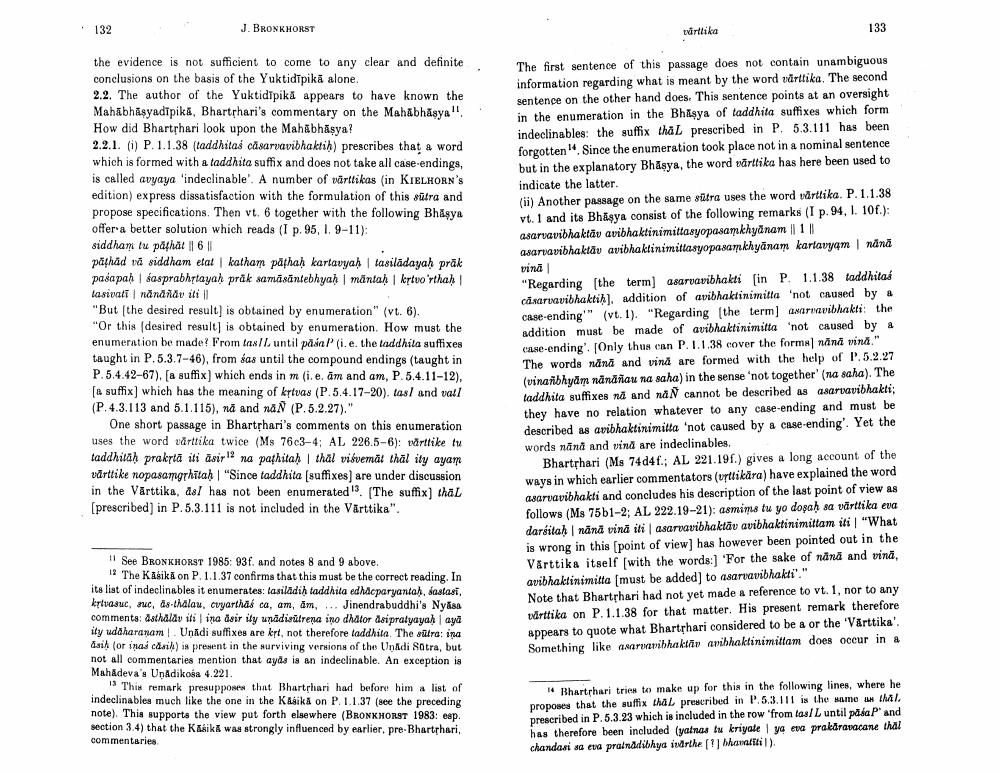________________
132
J. BRONKHORST
drttika
133
the evidence is not sufficient to come to any clear and definite. conclusions on the basis of the Yuktidipika alone, 2.2. The author of the Yuktid pikå appears to have known the Mahābhāşyadipika, Bharthari's commentary on the Mahabhāsya". How did Bharthari look upon the Mahabhâsya? 2.2.1. (1) P. 1.1.38 (taddhitas cisaruavibhaktih) prescribes that a word which is formed with a taddhita suffix and does not take all case-endings, is called avyaya 'indeclinable'. A number of varttikas (in KIELHORN'S edition) express dissatisfaction with the formulation of this sutra and propose specifications. Then vt. 6 together with the following Bhişya offer a better solution which reads (I p. 95, 1. 9-11): siddham tu pathal 6 || pathad va siddham etat katham pathah kartavyah tasilādayah prāk pašapah basprabhatayah pråk samāsantebhyah mäntah kerto'rthah! lasivati nänänav ili 11 "But the desired result is obtained by enumeration" (vt. 6). "Or this desired result) is obtained by enumeration. How must the enumeration be made! From tasll until påón P (i.e. the taddhila suffixes taught in P. 5.3.7-46), from fas until the compound endings (taught in P.5.4.42-67), (a suffix) which ends in m (.e. am and am, P.5.4.11-12), (a suffix) which has the meaning of krivas (P.5.4.17-20). taal and vall (P.4.3.113 and 5.1.115), na and naN (P.5.2.27)."
One short passage in Bharthari's comments on this enumeration uses the word uirttika twice (Ms 76c3-4; AL 226.5-6): wartlike tu taddhilah prakrtā iti asir" na pathitah thal visemäl thality ayam vårttike nopasamgrhitah "Since taddhita (suffixes are under discussion in the Värttika, dsl has not been enumerated" (The suffix) thal (prescribed) in P.5.3.111 is not included in the Varttika".
The first sentence of this passage does not contain unambiguous information regarding what is meant by the word ditika. The second sentence on the other hand does. This sentence points at an oversight in the enumeration in the Bhisya of taddhita suffixes which form indeclinables: the suffix thaL prescribed in P. 5.3.111 has been forgotten". Since the enumeration took place not in a nominal sentence but in the explanatory Bhasya, the word varttika has here been used to indicate the latter. (ii) Another passage on the same sutra uses the word tarttika. P. 1.1.38 vt. 1 and its Bhasya consist of the following remarks (I p. 94, 1. 10f.): asarvavibhaktav avibhaktinimittasyopasamkhyanam ||1|| asarvavibhaktav avibhaktinimitasyopasankhyanam karlavyem | ndna vina "Regarding the term) asarvavibhakti [in P. 1.1.38 addhitas casarvavibhakti). addition of avibhaktinimitta 'not caused by a case-ending" (vt. 1). "Regarding the term anarnavibhakti the addition must be made of avibhaktinimitta 'not caused by a case-ending'. [Only thus can P. 11.38 cover the formal nina vina." The words nana and vina are formed with the help of P. 5.2.27 (vinařbhyam nänänau na saha) in the sense 'not together' (na saha). The taddhita suffixes nd and nan cannot be described as asarvavibhakti: they have no relation whatever to any case-ending and must be described as avibhaktinimitta 'not caused by a case-ending! Yet the words nānd and vind are indeclinables.
Bharthari (Ms 74d4f.; AL 221.19.) gives a long account of the ways in which earlier commentators (urttikara) have explained the word asaruavibhakti and concludes his description of the last point of view as follows (MS 75b1-2; AL 222.19-21): asmims tu yo dogah sa vårttika eva darsitahnänä vinä iti asaruavibhaktāv avibhaktinimittam ili "What is wrong in this point of view) has however been pointed out in the Varttika itself (with the words:) 'For the sake of nana and vina, avibhaktinimitta (must be added) to asarvavibhakti"." Note that Bharthari had not yet made a reference to vt. 1, nor to any tarttika on P. 1.1.38 for that matter. His present remark therefore appears to quote what Bharthari considered to be a or the 'Varttika'. Something like an anibhaktiv arbhaktinimittam does occur in a
" See BRONKHORST 1985: 93f. and notes 8 and 9 above.
12 The Kasik on P. 1.1.37 confirms that this must be the correct reading. In its list of indeclinables it enumerates: lasiladih laddhita ed Meparyantah, salasi, kytuosue, nu, ds-thalau, cuyarthas ca, am, am ... Jinendrabuddhi's Nyasa comments: Bathala ili lina doir ity anddistrena ino dhator dsipratyayah ayd ity wdaharanam . Un di suffixes are kept, not therefore addhita. The sura: ina asih (or inai cash) is present in the surviving versions of the Unadi Sotra, but not all commentaries mention that ayds is an indeclinable. An exception is Mahadeva's Un dikosa 4.221.
" This remark presupposes that Bharthari had before him a list of indeclinables much like the one in the Kasika on P. 1.1.37 (see the preceding note). This supports the view put forth elsewhere (BRONKHORST 1983: esp. section 3.4) that the K Kaikk was strongly influenced by earlier, pre. Bharthari commentaries
# Bharthari tries to make up for this in the following lines, where he proposes that the suffix thaL prescribed in P.5.3.111 is the same as thil. prescribed in P.5.3.23 which is included in the row from taslL until padaP' and has therefore been included (yatnas tu kriyale ya era prakdramacone thal chandasi sa era pralnodibhya inarthe (Whanaliti).




